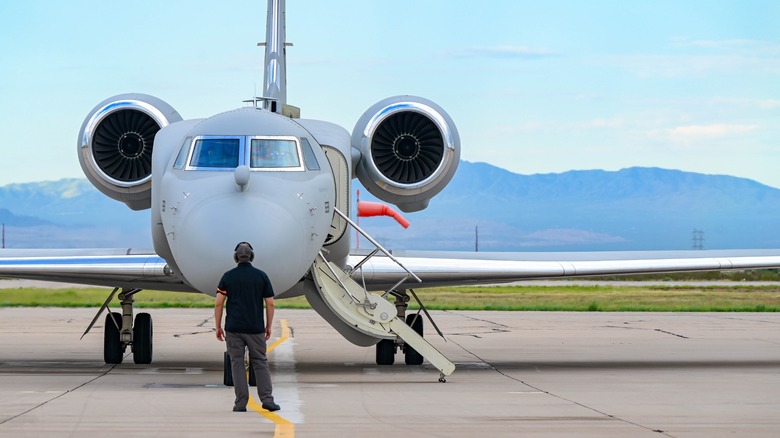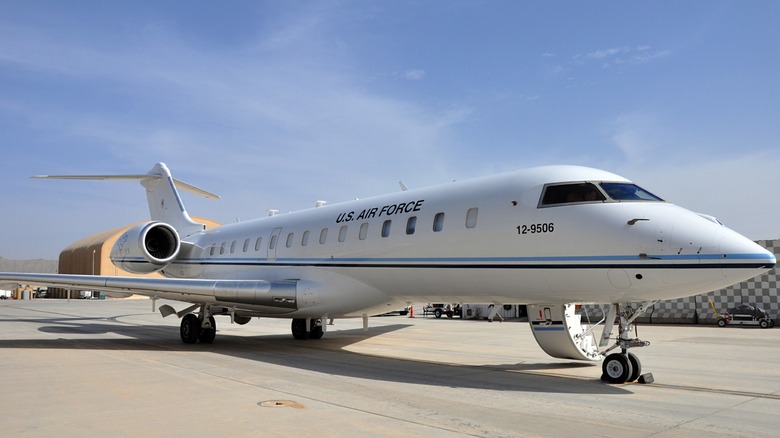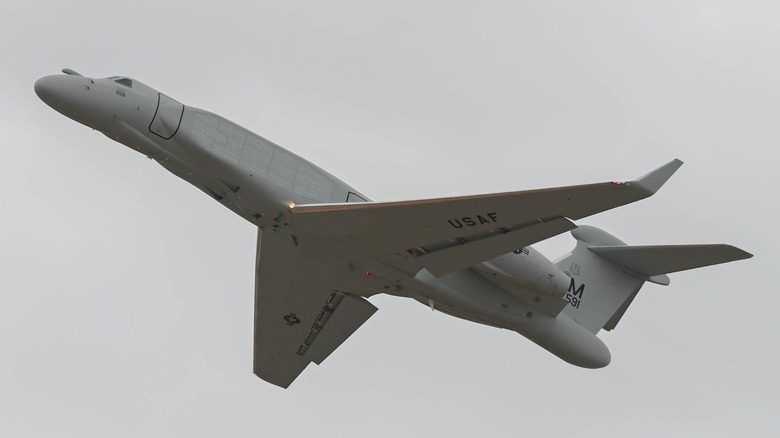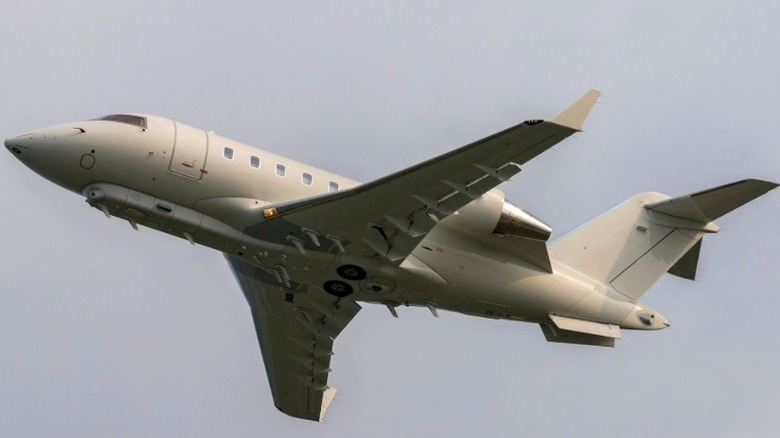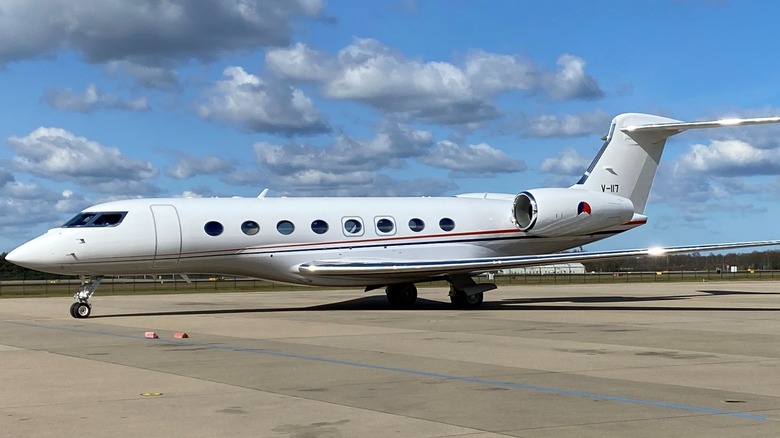5 Private Jets With Military Variants That Fly Air Force Missions
At first glance, private jets and military aircraft may not seem like they have a lot in common aside from their ability to fly. The former, after all, are products designed for the rich and famous, jetting them and their closest associates in the sort of luxury you won't find in commercial airplanes. The latter, on the other hand, are high-tech, specialized aircraft, often designed to fit combat criteria such as the U.S. Air Force's NGAD program.
While the civil and military aviation realms are indeed worlds apart on paper, there have been occasions where the two have intersected. The U.S. military has used civilian jets in the past, for example, with planes like the Boeing 767 serving as airborne refueling. Private jets have also seen use in military contexts, especially for low-volume and ultra-specialized tasks where developing a new military plane would not be cost-efficient. After all, why spend billions designing and building a handful of dedicated planes when you can adapt a proven private jet platform to your needs?
Now, to be clear, you won't find these engaging in ground assault operations or dogfights, so don't get your hopes up about seeing a Bombardier plane flying into battle with guns blazing. Instead, many of these serve in airborne intelligence, surveillance, and reconnaissance (A-ISR) and transport roles. But with that caveat out of the way, let's get going.
Bombardier Global 6000
If you're a keen follower of aviation news, you're probably familiar with the Bombardier name for its range of private jets — one of which very nearly breaks the speed of sound. But the Canadian company has a line in more than just ultra-luxe, ultra-fast private jets for the well-heeled. Its defense division has links with many of the world's militaries, providing a selection of jets for their use — one of which is the Global 6000.
The Global 6000 has found military use purely as a means of transport for a nation's top brass. For example, the German Luftwaffe has taken advantage of the jet's 6,000-nautical-mile range to transport the nation's politicians across the globe. Some militaries have opted to use the Global 6000 as more than just a means of transport, though. The U.S. Air Force, for example, ordered six Global 6000s in 2021 for its Battlefield Airborne Communications Node (BACN) program, based on the E-11A.
BACN uses aircraft to keep all participants in a battle connected via voice and data streams, a role that some have likened to "Wi-Fi in the sky." The Global 6000 seems to have proven particularly suited to the task, as the U.S. Air Force took delivery of its eighth BACN-equipped Bombardier Global 6000 in 2024, despite only ordering six to begin with. The German military has also expanded its use of the Global 6000, with a specially-modified example for its PEGASUS signals intelligence program successfully completing a test flight in 2024.
Bombardier Global 6500
The Bombardier Global 6500 is a relatively new addition to the company's portfolio, debuting alongside the Global 5500 in 2018. The main selling point over the Global 6000 was the increased range, with the 6500 offering an extra 600 nautical miles of travel and improved fuel economy.
That improved range wasn't just a boon for high-rollers constantly criss-crossing the planet; it also gives the Global 6500 18 hours of endurance, which is likely why the U.S. Army has opted to use Global 6500s at least twice in recent years. The first of these two examples was an August 2023 contract for two 6500-based A-ISR aircraft, to be built by MAG Aerospace and L3Harris. These modified 6500s are part of the U.S.' Army Theatre Level, High-Altitude Expeditionary Next Airborne (ATHENA) program, which has the express purpose of offering advanced, high-endurance A-ISR. The two companies delivered the second of these modified Global 6500s in 2025.
In December 2023, the U.S. Army awarded a contract to Bombardier Defense for one Global 6500 (with an option for two more, if necessary) that would serve as a prototype aircraft for its new High Accuracy Detection and Exploitation System (HADES), intended to keep the U.S. Army at the forefront of military surveillance and intelligence gathering. Bombardier delivered the HADES prototype Global 6500 in November 2024, and it's not yet clear whether the Army will take up the option of ordering the extra couple of Global 6500s outlined in the contract.
Gulfstream G550
So far, we've covered two aircraft that are still in production, with companies building them for private and military clients simultaneously. But let's turn to a private jet that continued life as a military plane after being discontinued: the Gulfstream G550. The G550 was a long-lived offering, staying in production for nearly 20 years and becoming the ultra-expensive private jet of choice for athletes such as Tom Brady and Tiger Woods — alongside playing a role in the Israeli military's surveillance fleet, beginning in 2010 and continuing into the 2020s in updated form.
But it's not just the Israeli military that flies modified G550s; the U.S. also has a version, dubbed the EA-37B Compass Call. Designed to replace the Lockheed EC-130H Compass Call, the EA-37B is an electronic warfare variant of the G550 CAEW platform used by the Israeli military. The Air Force first signed a contract for a single Compass Call with L3 Technologies (now L3Harris) in 2017, before purchasing more over the next two years. Overall, the U.S. Air Force is expected to take delivery of 10 EA-37Bs, porting the Compass Call technology from the EC-130H fleet to the new planes.
Despite having been contracted to build the first EA-37B in 2017, L3Harris didn't deliver the first example for testing until after Gulfstream discontinued the G550. The Air Force received its first EA-37B (then known as the EC-37B) in 2023, and flew its first training sortie with the plane in 2025 — the same year that Italy signed a contract for two EA-37Bs.
Bombardier Challenger 650
Bombardier claims that its Challenger 650 is its best-selling large private jet, citing its roomy cabin, low running costs, and solid 4,000-nautical-mile range as reasons for its popularity. And, while we can't speak for any of the world's militaries, it's not hard to imagine that some (or all) of these factors play a role in how relatively common it is to see Challenger 650s bearing national flags: the UAE, Finland, and Canada — to name a few — all fly the Challenger 650 for medevac, transportation, and surveillance purposes.
The U.S. Army also has a history with the private jet, with a couple of modified Challenger 650s serving as part of its ARTEMIS (Airborne Reconnaissance and Target Exploitation Multi-Mission System) effort. These first-gen planes racked up over 550 flight hours, keeping an eye on hot spots such as the Russia-Ukraine border. Built by American firm Leidos, the ARTEMIS Challenger 650s are unique on this list for having been built entirely privately, without any contracts or funding from the U.S. military. Leidos builds, maintains, and flies these modified private jets, offering its services to the U.S. Army in exchange for a fee.
Such a deal seems to have worked out for both parties, as Leidos unveiled an updated version, ARTEMIS II, in 2022. Still based on the Bombardier Challenger 650, the ARTEMIS II continues its predecessor's target acquisition and A-ISR roles, capable of listening in on enemy communications from 40,000 feet in the air. By 2024, Leidos' ARTEMIS planes had flown a combined 10,000 hours for the U.S. Army.
Gulfstream G650ER
We end our list with a slightly less aggressive military use of a private jet. The Gulfstream G650ER, as far as we know, has not yet been selected to serve as a platform for A-ISR, target acquisition, or electronic warfare, but that doesn't make it any less important for some militaries.
More specifically, it plays a potentially life-saving role for the Italian Air Force, which took delivery of two G650ERs in April 2025 for high-stakes medical transport missions. The Gulfstream G650ERs will replace the Dassault Falcon 50 and Falcon 900s — the latter probably most known for being Taylor Swift's private jet of choice — that the Italian Air Force has been using until now. Despite having been discontinued at the start of the year, the G650ER still ranks as one of the fastest passenger jets ever, with a maximum speed of Mach 0.925 and a cruising speed of Mach 0.85.
Couple that with a range of 7,500 nautical miles when cruising, and it's not hard to see why the Italian Air Force opted for the G650ER for its critical medical missions. It's already been put to use, too, helping transport a two-month-old baby from Sardinia to Turin, where she could receive treatment. Like other private jets, the Gulfstream G650ER also serves a more mundane role as transportation for an army or a nation's upper echelon. The Royal Netherlands Air Force, for example, has operated at least one Gulfstream G650ER since 2023.
